
Search Wild Foods Home Garden & Nature's Restaurant Websites:
Groundnut (Hopniss)
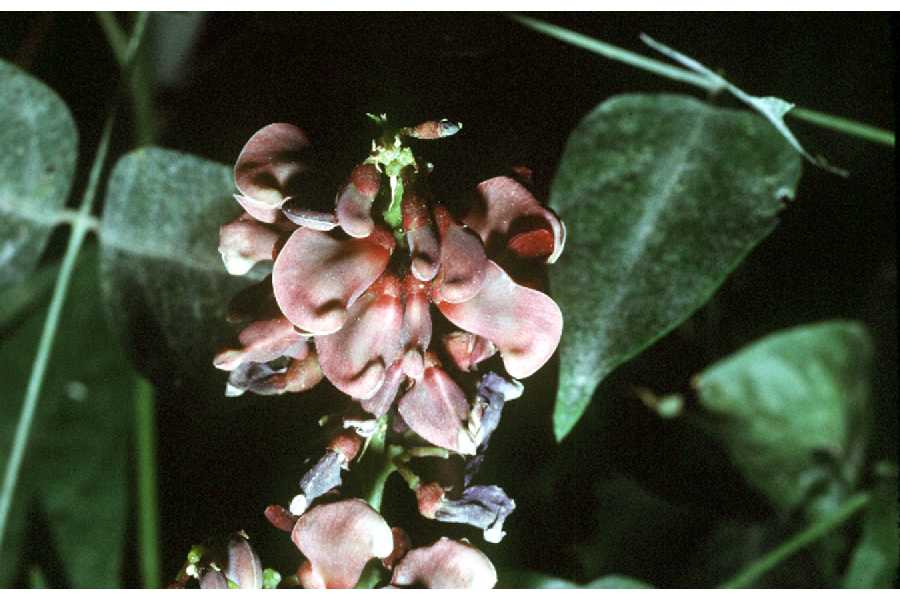
Groundnut (Hopniss) in flower. (Robert H. Mohlenbrock, hosted by the USDA-NRCS PLANTS Database / USDA SCS. 1989. Midwest wetland flora: Field office illustrated guide to plant species. Midwest National Technical Center, Lincoln)
(NOTE: If you are not interested in growing Groundnut, but just finding the plant and using it, try going to the Nature's Restaurant Online site for Groundnut.)
Groundnut or Hopniss (Apios americana). Other names are Indian Potato and Potato Bean. Likes to grow in damp ground along the edges of creeks and rivers, ponds and marshes, but not in them. They tend to be in partly sunny / partly shady areas associated with openings in woods. Though native to North America, they are now a cultivated crop in Japan where they are appreciated for their health benefits and high protein levels. It is my understanding that there is research ongoing to see if this could be a commercial crop in North America. One of the names for this plant is the Indian Potato, this was a food well utilized by Native North Americans. This was one of the foods shown to the European Settlers by the Natives when the Europeans first came to North America.
Soil & Site: If you have the right conditions (damp, sandy or loamy soil) you will have no trouble growing this plant at home. As long as the soil they grow in is moist enough, they can be in full sun. The soil can be a little acidic to slightly alkaline. Plant next to something the vine can climb - treat it like climbing beans or peas. The ideal place to plant them is where the ground is shaded and the vines get full sun. They don't need to be fertilized - especially with nitrogen, as they fix their own out of the air and add it to the soil themselves. If you have your soil tested, and it is low in other nutrients, you can add them.
Seeds: They can be started by bean. In the fall if you know where they are, gather the dried pods with the beans and plant in the spring. Plant like any other bean or pea.
Planting Tubers: Find the vines, dig up the tubers in the fall, plant at home, and by next spring you should have it growing. Plant them the same depth you found them. After planting put a layer of mulch over the area.
Maintenance: Once established, there isn't much to do for them. After harvesting in the fall, put some mulch over the area. The main thing to keep in mind is the soil should not dry out completely. This is where the mulch comes in, as it adds organic matter to the soil and helps the soil retain moisture. In the fall of the first year you have it, dig up the tubers and replant spaced apart and you will have multiple vines the year after.
Harvesting: The tubers can be fairly small to as big as a large potato, and are daisy-chained on the roots. That is, they are like well spaced pearls on a string. The roots and tubers grow horizontally under the ground, and if the ground is sandy, they are fairly easy to gather. Not so easy in clay soils. Just dig them up, and leave or replant the smaller ones for next year's crop.
Using: Don't eat them raw. I suggest they be cooked, even though I have read on the web some people say they taste good raw. I find they sit like a lump in my stomach and give me cramps unless cooked. Cooked, they are very good. You have to peel them (peel as if they are potatoes), so the really tiny ones are best replanted when harvesting for growing next year's crop. They can grow really big (bigger than an orange), but these tend to be a little woody. Chicken egg sized is about right. When you peel them, you will notice a sticky, milky like sap - that is normal. Put in water in a stainless steel or glass pot (hard to clean up any other kind - they leave a residue) and cook until soft. You will notice the water is a dull gold-yellow when they are cooked. Pour the water away.
At this point, you can use them like potatoes - in other recipes, mashed, etc. There is only one rule - eat them very warm, the taste and texture is odd when they cool. You can reheat them.
Identification: They are a nitrogen-fixing legume vine that climbs by twisting around other plants, branches or anything in a counter-clockwise direction. Leaves are compound (5 to 7 leaflets per leaf), and the leaves are alternate on the vine (not opposite each other). In eastern North America where it is native, it seems to be found wherever the conditions are right. As it is a legume like Peas, it has edible bean pods that are 5 to 130 mm (2 - 5 inches) long that look like Pea pods. The flower spikes have many flowers on them, and the color is hard to describe. Sort of pinkish, purplish, brown, dull maroon. The flower is very complicated looking, kind of like a Snapdragon flower. The flower spikes come from the same part of the vine that the compound leaves attach.
Caution: When looking for this plant to get tubers to plant, please know what Poison Ivy, Western Poison Ivy (Toxicodendron radicans) and especially Poison Sumac (Toxicodendron vernix) look like before hunting for the Groundnut, as they like the same types of areas, so you are likely to encounter them. Also, the compound leaves, and even the flower spikes, at some stages, look enough like the Poison Sumac that unless you know them both by sight, a terrible mistake could be made by handling the Poison Sumac. Another important point: If you see Groundnut vines growing right where there is Poison Ivy, Western Poison Ivy or Poison Sumac, don't dig for them there. Touching the roots of the Poison Ivy or Sumac is just as bad or worse than touching the parts of the plant above ground.
Description:
- USDA Plant Hardiness Zone: 3-10 (More information on hardiness zones).
- Soil pH: 5.6-7.5
- Plant Size: Counter-clockwise twining (wraps around) Vine without tendrils, up to 4 meters (13 feet) long
- Duration: Perennial
- Leaf Shape: Compound, Odd Pinnate with 5-7 leaflets.
- Leaf Phyllotaxis (Arrangement) on branch: Alternate - one compound leaf per node on the vine stem. Leaflets are opposite on leave with single terminal leaflet
- Leaf Size: Compound leaf is 8-15 cm (3 to 6 inches) long.
- Leaf Margin: On each leaflet the edge is Entire (smooth).
- Leaf Notes: The base of the leaf comes from the same spot (node) on the stem that the flower cluster stem comes from.
- Flowers: Flowers are in clusters on a stem. The flower is vertically bilaterally symmetrical, which means: if you imagine a line from top to bottom of the center of the flower, each side is a mirror image. If you divide it horizontally, the halves are not mirror images. Pinkish, purplish, brown, dull maroon color.
- Fruit: Bean pods that are 5 to 13 cm (2 - 5 inches) long that look like Pea pods
- Habitat: Damp areas by marshes, rivers, creeks, ponds. Very often in woods or beside woods in damp areas with enough light. Needs at least partial sun.
Web Resources:
- Recipe search on the web here (Google search) and here (Bing search).
- Pictures on the web here (Google images) and here (Bing images).
- Interactive USDA distribution map and plant profile here.
- The Biota of North America Program (BONAP) distribution map here. BONAP map color key here.
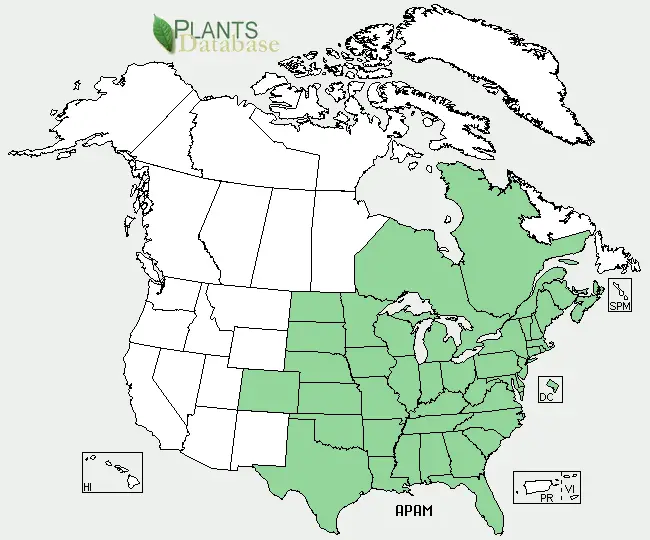
Groundnut or Hopniss (Apios americana) range. Distribution map courtesy of U. S. Department of Agriculture (USDA Natural Resources Service) and used in accordance with their policies.
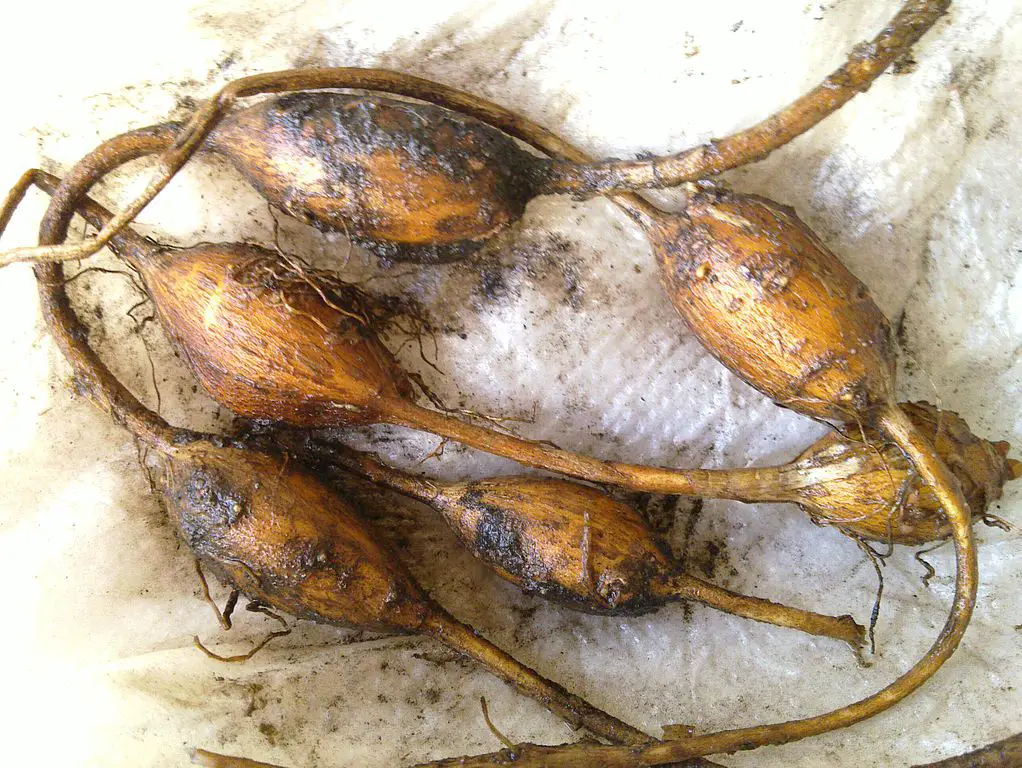
Groundnut or Hopniss (Apios americana). The edible tubers. (By: Malte CC BY-SA 3.0)
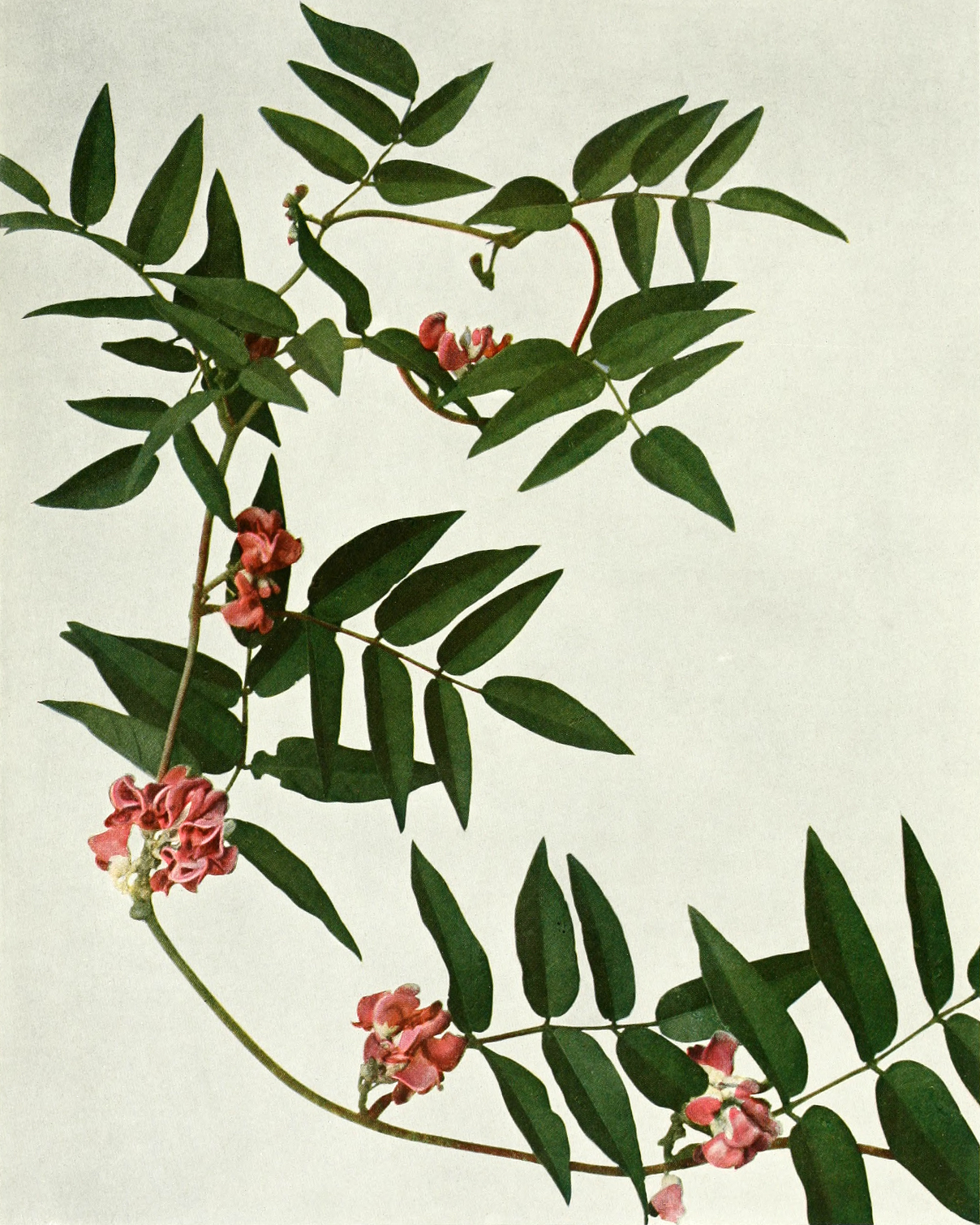
Groundnut or Hopniss illustration of above ground part of plant. (Wild Flowers of New York Part 1, University of the State of New York, State Museum, Albany)
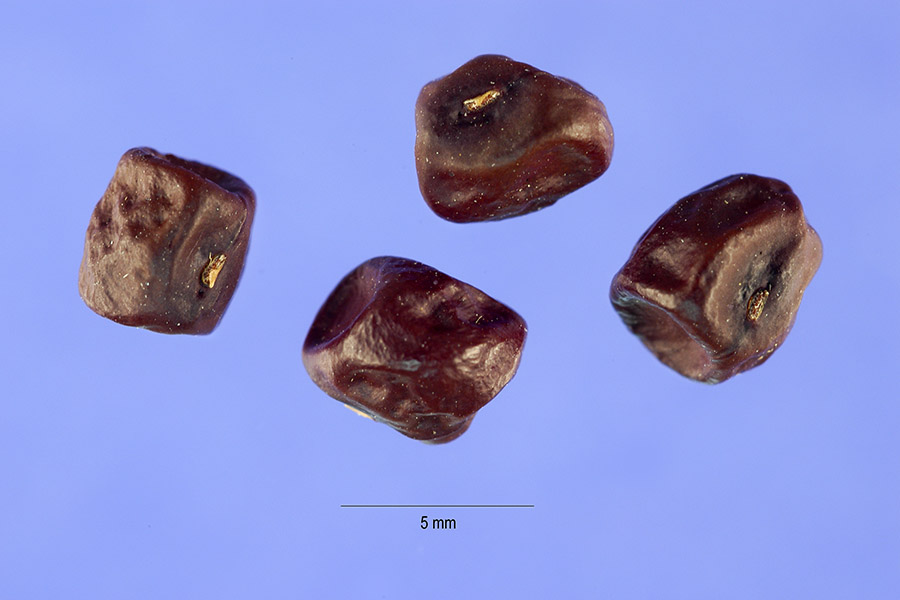
Groundnut or Hopniss seeds. (Steve Hurst, hosted by the USDA-NRCS PLANTS Database)
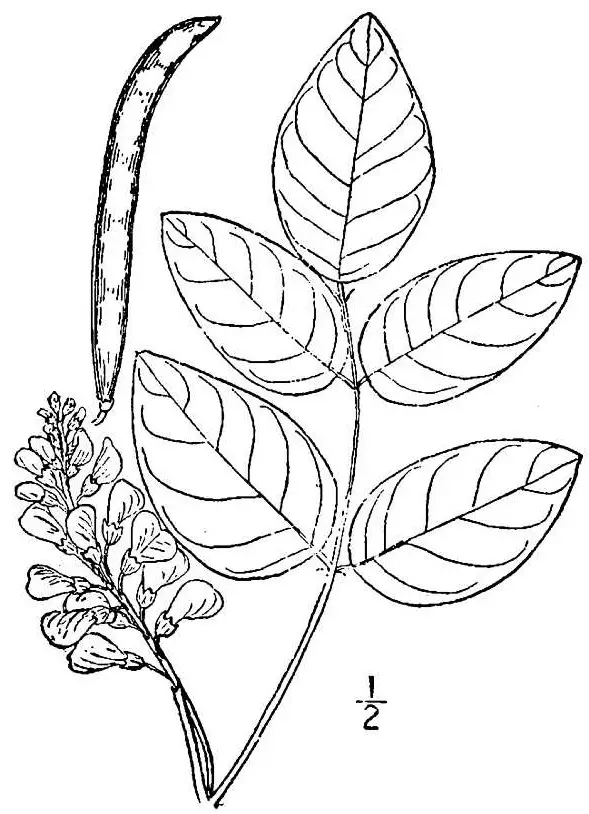
Groundnut or Hopniss drawing showing what the seed pod looks like. (USDA-NRCS PLANTS Database / Britton, N.L., and A. Brown. 1913. An illustrated flora of the northern United States, Canada and the British Possessions. 3 vols. Charles Scribner's Sons, New York. Vol. 2: 418.)
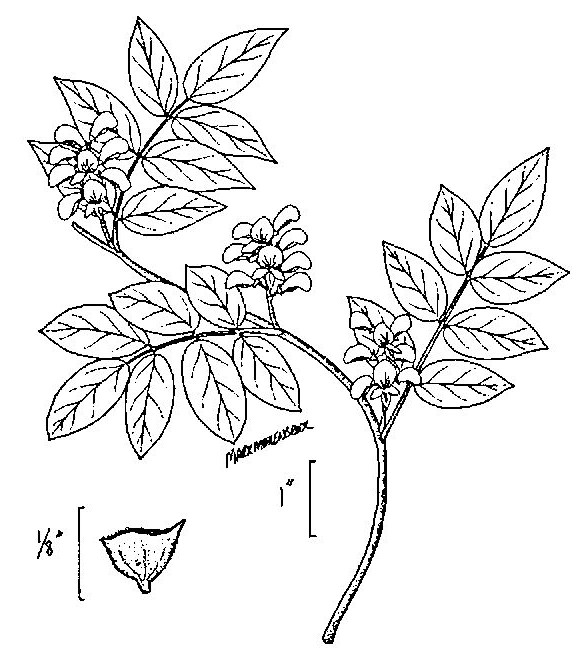
Note that both the flower spike and leaf base come from the same spot (node) on the vine. The leaves are alternate on the vine, but the leaflets are opposite on the leaf. There are five or seven leaflets per leaf. The flower spike contains many flowers that look like Sweet Pea or Snapdragon flowers, but in a dull pinkish, purplish, brownish maroon color. (USDA-NRCS PLANTS Database / USDA NRCS. Wetland flora: Field office illustrated guide to plant species. USDA Natural Resources Conservation Service.)
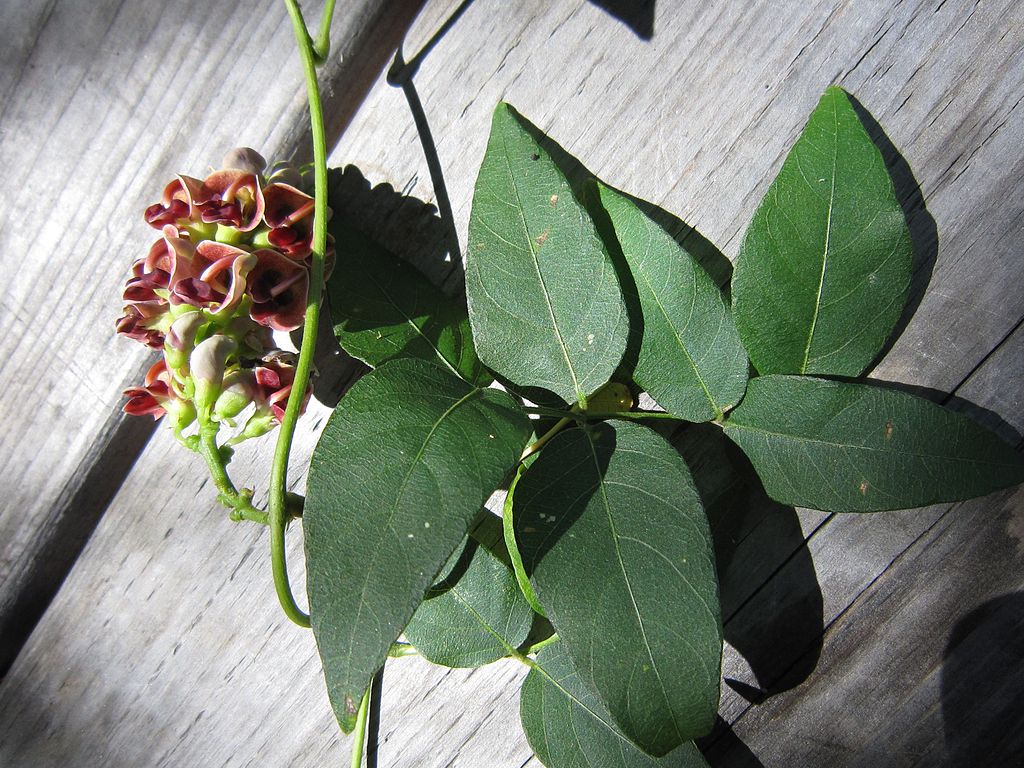
Groundnut or Hopniss (Apios americana) flowers and leaves. This picture shows well what each leaflet on the leaf looks like. (By: Mageejp GNU Free Documentation License, Version 1.2)
Search Wild Foods Home Garden & Nature's Restaurant Websites:
Share:
Why does this site have ads?
Originally the content in this site was a book that was sold through Amazon worldwide. However, I wanted the information to available to everyone free of charge, so I made this website. The ads on the site help cover the cost of maintaining the site and keeping it available.
Google + profile
